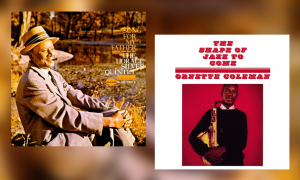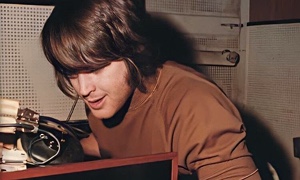Home » Jazz Articles » Building a Jazz Library » Horace Silver: His Only Mistake Was To Smile
Horace Silver: His Only Mistake Was To Smile

From a historical point of view, Silver’s cheerful face, his default countenance on stage, has done him no favours. It has fostered a perception that he was a lightweight figure, more of an entertainer than an innovator. The truth is profoundly otherwise. Silver was a radical and a pioneer. Spoiler alert: jazz can be fun.
From a historical point of view, Silver's cheerful face—his natural, default expression on stage—has done him no favours. It has fostered a perception that he was a lightweight figure, more of an entertainer than an innovator. The truth is profoundly otherwise. As a pianist, a composer and a bandleader, Silver was a seminal force in the birth and development of hard bop and the soul jazz that emerged out of it. He was a radical and a pioneer and his work has legs. Any jazz library that does not include a solid chunk of his catalogue is deficient, and missing a whole lot of fun. (Spoiler alert: jazz can be fun). On entering the House of Silver, po-faces need to be checked at the door.
One could add that Silver's other mistake was to go public in the late 1960s with his disapproval of all drug taking. Weed smokers took issue with that, and would still today. But Silver had white powders at the front of his mind, and anyone who knows the damage done by heroin and cocaine would side with him there.
Ten of Silver's greatest albums are discussed below. But first, the back story...
The Quest For Meaningful Simplicity
Silver set out his artistic manifesto in the sleeve note for Serenade To A Soul Sister (Blue Note, 1968). With characteristic concision, he listed his "guide lines to musical composition." There were five of them. Melodic beauty; meaningful simplicity; harmonic beauty; rhythm; environmental, hereditary, regional and spiritual influences. If there was a single one that most defined Silver's work it would be meaningful simplicity.Achieving meaningful simplicity, said Silver, was not easy. In Joe Goldberg's Jazz Masters of the 50s (Macmillan, 1965), he said: "I've found in composing that being simple and profound—having in-depthness in your music—is the most difficult thing to do. Anybody can write a whole lot of notes, which may or may not say something."
Thelonious Monk, Silver's near contemporary, said precisely the same thing. Perhaps not coincidentally, Silver's pianism was a first cousin of Monk's: percussive, hard swinging, earthy, shot through with gospel and the blues, sometimes borderline dissonant, involving spare, iterated, single-note right-hand figures that had the tenacity of boogie-woogie motifs. Silver did not share Monk's stride-derived left hand but, that aside, there are times when the one player could almost be mistaken for the other.
Silver's embrace of meaningful simplicity began in his pre-teens, when as a budding pianist he was immersing himself in North American indigenous music. In an interview with Michael Ullman for New Republic magazine in 1978, Silver said: "My first introduction to jazz was boogie-woogie... Earl Hines had 'Boogie-Woogie On The St Louis Blues,' Eddie Heywood had a boogie-woogie arrangement on 'Begin The Beguine.' I copied [them] off the record by ear. I copied some of Jay McShann off the records. I was about twelve. I used to be the hit at the little teenage parties."
Rough Diamonds Vs Polished Sterilities
Silver told Ullman he also listened to the blues. "I liked and still do like all them old downhome blues singers like Muddy Waters, Lightnin' Hopkins, Peetie Wheatstraw (the devil's son in law), Memphis Minnie. I dig the feeling. They weren't technicians but they had a whole lot of feeling. It was diamonds in the rough, unpolished diamonds."When it came to composing, Silver had multiple styles and at the same time just one style. The multiplicity came from the range of forms in which wrote: gospel-infused groove tunes, funked-up blues, Latin vamps, ballads, gentle mood pieces, the occasional serpentine bopper. The oneness came from the way Silver executed his compositions. Whatever their outward form, they used the minimum necessary number of notes and had irresistible forward momentum, appealing melodies and hook lines big enough to snag a runaway truck. Many of his pieces had secondary themes, and rhythmic devices such as Latin beats played off against straight 4/4 sections.
Silver was born in Norwalk, Connecticut in 1928. His mother was of Irish and Black heritage, his father had emigrated to the US from the mid-Atlantic Cape Verde islands as a young man. At family parties, Silver's father and uncle would get out guitars and play Cape Verdean music. Silver told Michael Ullman he found it "corny" at the time. He studied tenor saxophone as well as piano at high school. In 1950, Stan Getz heard him playing piano in a Connecticut nightclub and hired him for his band. Silver stayed for a year and Getz recorded three of his tunes: "Penny," "Potter's Luck" and "Split Kick." In 1951, Silver moved to New York, where he was soon gigging in bands led by Coleman Hawkins, Oscar Pettiford, Lester Young and Art Blakey.
By the mid 1950s, Silver was on the cusp of forming his own band and his greatness rings out on several sideman dates of the period. These include Miles Davis' 10" LP Miles Davis All Star Sextet (Prestige, 1954, released with added tracks as 12" LP Walkin'), Blakey's A Night At Birdland Volume One and Volume Two (both Blue Note, 1954), and Kenny Clarke's Bohemia After Dark (Savoy, 1955).
In 1954, Silver led a quartet at Minton's Playhouse that included tenor saxophonist Hank Mobley and bassist Doug Watkins. Invited by Blue Note's Alfred Lion to put together a band for a record date, Silver called on Mobley, Watkins, Blakey and trumpeter Kenny Dorham. For the session, the band was called the Horace Silver Quintet, but by late 1955 the name had changed to The Jazz Messengers.
Which is where this Top Ten begins...
Ten Pieces of Silver
Between 1952 and 1979, Silver recorded twenty-seven albums for Blue Note, including two live discs. They are of consistently high quality and those made between 1956 and 1966, Silver's purple period, are all exceptional. Silver recorded some memorable albums after this, but it would be disingenuous to pretend his 1956 to 1966 recordings are anything other than his greatest. This Top Ten is drawn exclusively from them. Of Silver's later albums, Pencil Packin' Papa (Columbia, 1994) and The Hard Bop Grandpop (Impulse!, 1996) are among the best. Silver made his final recording in 1998 for Verve—it was titled, appropriately (and defiantly), Jazz Has A Sense Of Humor. He passed in 2014. Horace Silver And The Jazz Messengers
Horace Silver And The Jazz Messengers Horace Silver And The Jazz Messengers
Blue Note
1956
Horace Silver And The Jazz Messengers is a reissue combining two 10" LPs released in 1955 by the Horace Silver Quintet. The discs were Silver's first leading a quintet (he recorded a trio album for Blue Note in 1952), the format he favoured going forward. He wrote seven of the eight tracks, establishing another pattern, in which he composed the overwhelming majority of the material on his albums. Two tracks in particular chimed with the emerging back-to-the-roots zeitgeist in African American jazz: Silver's "The Preacher" and "Doodlin'" were key in establishing hard bop's initial direction. In the aforementioned Jazz Masters of the 50s, Silver says that Alfred Lion wanted to bin "The Preacher," saying it was "too old timey, that no one would go for it." Well, even visionaries and geniuses get it wrong sometimes. Anyway, Silver insisted on the track's inclusion on the album and in 1955, as a single from one of the 10" LPs, it was a sizeable jukebox hit. In 1956, organist Jimmy Smith covered it on his debut album, A New Sound... A New Star... " (Blue Note), and as a single the track was an even bigger hit for him than it had been for Silver.
 Horace Silver Quintet
Horace Silver Quintet6 Pieces Of Silver
Blue Note
1956
Hank Mobley and Doug Watkins are still on board for 6 Pieces Of Silver, but Donald Byrd replaces Kenny Dorham and Louis Hayes replaces Art Blakey. Six of the seven tracks are Silver originals. The bluesy, Latin-flavoured "Señor Blues" was another jukebox hit, becoming one of Silver's evergreens. Another standout is the poignant ballad "Shirl;" while Silver is closely associated with down home, funky material, he also wrote exquisitely pretty ballads (check the YouTube clip of "Lonely Woman" below). With Blakey now leading the Jazz Messengers and Silver leading his own quintet, hard bop was developing two interrelated but distinct strands: Silver's generally sunny and buoyant approach and Blakey's darker, meaner version (which reached its apogee of badness in trumpeter Lee Morgan).
 Horace Silver Quintet
Horace Silver QuintetFurther Explorations
Blue Note
1958
Further Explorations was the last of Silver's 1950s albums to appear on CD, in 1997, when it was part of Blue Note's limited edition Connoisseur series, and it continues to be widely overlooked. Probably this is because none of the tunes are blues or gospel based and there is no flagwaver such as "The Preacher" or "Señor Blues." But the album is a compositional landmark and was recorded by a match-fit quintet which had been together for the best part of a year: trumpeter Art Farmer, tenor saxophonist Clifford Jordan, bassist Teddy Kotick and drummer Louis Hayes. Silver's quiet radicalism shines on "The Outlaw," which is based on a thirteen-bar line, and the ballad "Melancholy Mood," made up of three seven-bar phrases. Silver handles the asymmetry with a light touch: in the sleeve notes to Finger Poppin' (Blue Note, 1959), he says: "I don't stop to think about measures until after I'm finished writing. As long as they feel even and comfortable, that's all that counts." Also outstanding: the extended (eleven minute) medium-fast ballad "Moon Rays" (most of Silver's studio album tracks last around five to six minutes), with its occasional, unexpected, faint echoes of Miles Davis' Birth Of The Cool (Capitol, 1957).
 Horace Silver Quintet
Horace Silver QuintetFinger Poppin'
Blue Note
1959
On the magnificent Finger Poppin', Silver introduced three of the members of what is commonly regarded as his classic quintet: bassist Gene Taylor, and trumpeter Blue Mitchell and tenor saxophonist Junior Cook, two no-messing hard-bop horn players who, functioning rather like Charlie Rouse did in Thelonious Monk's quartet, delivered Silver's message with unshakeable conviction. Louis Hayes is retained on drums, later to be replaced by Roy Brooks. This line-up would take Silver through to autumn 1963. All eight tunes are Silver originals and most are shot through with blues and gospel retentions, while "Swingin' The Samba" was recorded and released a full three years before Stan Getz and Charlie Byrd's 1962 Verve album Jazz Samba (just saying). The album spawned three jukebox hits: "Come On Home" b/w "Finger Poppin,'" "Juicy Lucy" b/w "Cookin' At The Continental" and "Swingin' The Samba" b/w "Mellow D." The other two tracks are ballads: "Sweet Stuff," on which the horns drop out, and "You Happened My Way," built on another of Silver's unusual bar structures.
 Horace Silver Quintet & Trio
Horace Silver Quintet & TrioBlowin' The Blues Away
Blue Note
1959
If one was sent to the proverbial desert island and allowed to take only one Silver disc, Blowin' The Blues Away would be an excellent choice. All seven tracks on the original LP were Silver originals and every one is killer. They include the rocket fuelled title track, "The Preacher"-styled "Sister Sadie" and "Break City," the Near Eastern-tinged "The Baghdad Blues" and an outstanding ballad in "Peace," on which Blue Mitchell excels. Further Explorations' poignant "Melancholy Mood" is given a compelling seven-minute piano trio reading (Silver often included a trio track on his quintet albums). The biggest hit on release was "Sister Sadie," which is funky to the max and a fountainhead of soul jazz. A perfect masterpiece, Blowin' The Blues Away does just what the title suggests.
 Horace Silver Quintet
Horace Silver Quintet The Tokyo Blues
Blue Note
1962
Compared to the Dave Brubeck Quartet's contemporaneous Jazz Impressions Of Japan (Columbia, 1964), The Tokyo Blues, recorded following the Silver quintet's 1961 tour of Japan, includes few resonances of the country. Silver made new use of modal structures within his trademark blues and gospel infused, Latin-tinged hard bop, but Japan only really figures in the track titles: Silver's "Too Much Sake," "Ah! So," "The Tokyo Blues" and "Sayonara Blues" and Ronnell Bright's ballad "Cherry Blossom," the disc's trio workout. After five albums with the quintet, Louis Hayes had by now left to join another quintet with a sunny disposition, Cannonball Adderley's. His place had been taken by Roy Brooks. But Brooks, who was already living with the mental health issues which took a firmer grip a decade later, was indisposed during the recording of this album and Joe Harris stood in for him. Classic Silver throughout, with "The Tokyo Blues" and "Sayonara Blues" the standouts by a whisker.
 Horace Silver Quintet
Horace Silver QuintetSong For My Father
Blue Note
1964
According to Blue Note maven Michael Cuscuna, Song For My Father is among the label's all-time best-selling albums, up there with Lee Morgan's The Sidewinder (1964) and Lou Donaldson's Alligator Boogaloo (1967). The album was recorded at three sessions between October 1963 and October 1964 and has two lineups. "Calcutta Cutie" and "Lonely Woman" have the classic quintet with Blue Mitchell, Junior Cook, Gene Taylor and Roy Brooks; "Song For My Father," "The Natives Are Restless Tonight," "Que Pasa" and "The Kicker" have trumpeter Carmell Jones, tenor saxophonist Joe Henderson, bassist Teddy Smith and drummer Roger Humphries. Henderson in particular is a stellar inclusion in the band. He wrote the aptly named "The Kicker," the only non-Silver tune, and his solos on "Song For My Father" and "Que Pasa" are among the album's biggest takeaways.
 Horace Silver Quintet Plus J.J. Johnson
Horace Silver Quintet Plus J.J. JohnsonThe Cape Verdean Blues
Blue Note
1965
Recorded twelve months after Song For My Father, The Cape Verdean Blues has a largely new lineup. Joe Henderson is retained—contributing another fine original and generally blowing up his singular storm—along with Roger Humphries. But Carmell Jones has left, replaced by Woody Shaw on his first Blue Note session, and there is a new bassist, Bob Cranshaw. On three of the six tracks, the quintet is augmented by trombonist J.J. Johnson, with whom Silver had first recorded on Miles Davis' aforementioned Miles Davis All Star Sextet a/k/a Walkin' a decade earlier. Johnson's presence allows Silver to arrange for a three-horn frontline, and the trombonist contributes a particularly strong solo on "Bonita." On release, the album was overshadowed by the still kicking Song For My Father, but the standard of writing, and playing, is every bit as high.
 Horace Silver Quintet
Horace Silver QuintetLive New York Revisited
ezz-thetics
2022
By all accounts, Silver did not much care for making live albums. In his 1950s and 1960s heyday, live recording was a hit-and-miss affair and studio recordings delivered superior sound. (There were exceptions to this, of course. Ray Charles' 1960 Atlantic album In Person, recorded with a single microphone suspended over the stage during a stadium concert in Atlanta, Georgia, is a sonic as well as a musical masterpiece.) However, Silver might have been pleased with Live New York Revisited . Recorded at three New York club engagements in 1964, 1965 and 1966, the material has been transformed by the Swiss-based ezz-thetics' label's remastering jedi Michael Brändli. "Song For My Father," "The Natives Are Restless Tonight" and "Que Pasa" are played by the band which recorded them on Song For My Father. "Señor Blues" from 6 Pieces Of Silver, the title track from Tokyo Blues and "African Queen" from The Cape Verdean Blues have Woody Shaw in place of Carmell Jones and Larry Ridley in place of Teddy Smith. Magic.
 Horace Silver Quintet / Sextet
Horace Silver Quintet / SextetThe Jody Grind
Blue Note
1967
Silver stuck with the quintet / sextet format on The Jody Grind, with James Spaulding added on alto saxophone and flute on three of the six tracks, all Silver originals. Woody Shaw, Larry Ridley and Roger Humphries are still in the quintet, but there is a new tenor saxophonist, Tyrone Washington. (Factoids: Washington grew up in the same Newark, New Jersey house as his contemporary Woody Shaw, who recommended him to Silver. He retired from music in the mid 1970s, changed his name to Bialar Mohammed, and returned to Newark.) Bright and sunny, and therefore out of step with the pained rictuses (see above) which were by 1967 the norm in American jazz, The Jody Grind is a groove-centric delight, one of the most consistently funky discs in Silver's discography and irresistible from start to finish. It was followed by 1968's Serenade To A Soul Sister, Silver's final Alfred Lion-produced session, another strong album. But The Jody Grind gets the cigar as Silver's last five-star masterpiece.
Tags
PREVIOUS / NEXT
Support All About Jazz
 All About Jazz has been a pillar of jazz since 1995, championing it as an art form and, more importantly, supporting the musicians who make it. Our enduring commitment has made "AAJ" one of the most culturally important websites of its kind, read by hundreds of thousands of fans, musicians and industry figures every month.
All About Jazz has been a pillar of jazz since 1995, championing it as an art form and, more importantly, supporting the musicians who make it. Our enduring commitment has made "AAJ" one of the most culturally important websites of its kind, read by hundreds of thousands of fans, musicians and industry figures every month.























